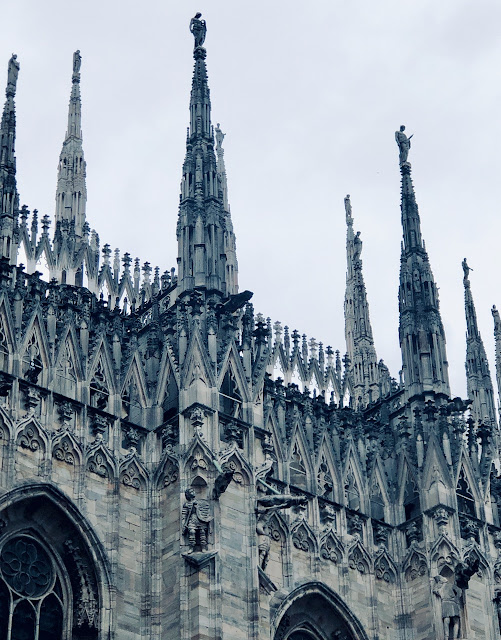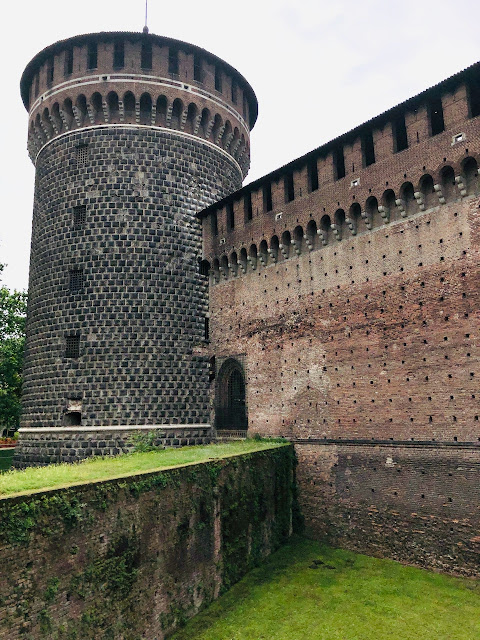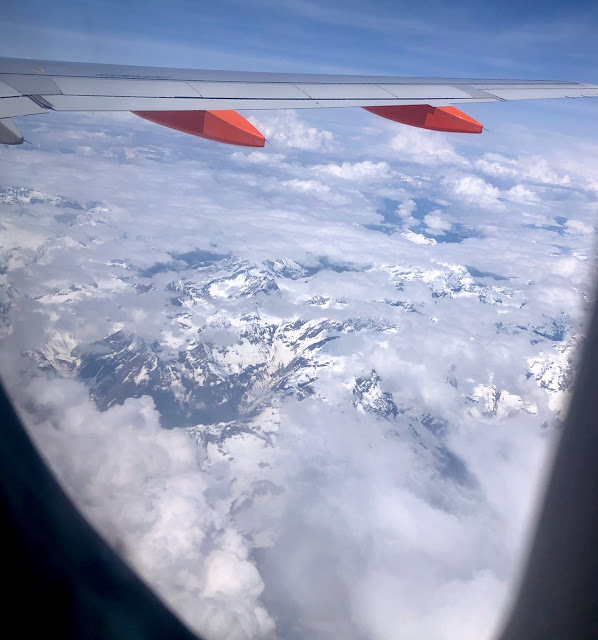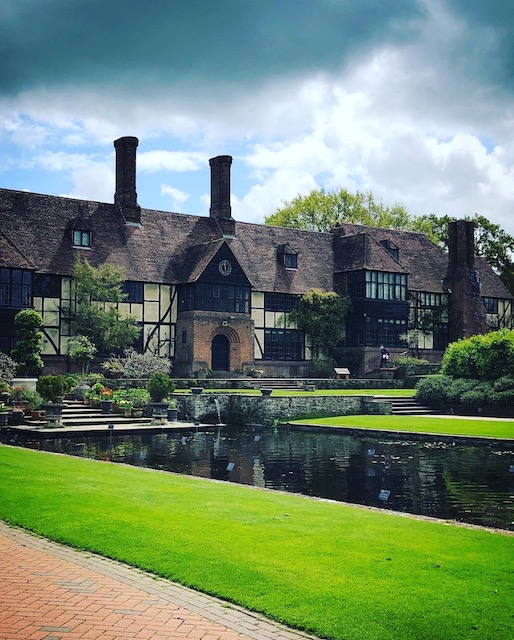 |
| The glorious Duomo di Milano (Milan Cathedral) in early evening sunshine |
Greetings, Readers!
Yes, from the title you can tell this will be yet another blog post that, in part, bemoans the hellishness of hot weather.
I am currently 'at leisure' for a period, having recently put my hand up for a voluntary redundancy from the charity for which I've worked for 6.5 years. To be honest, I had been working full-time almost without pause for 42.5 years. I had only a couple of short gaps during that period, when I worked 'slightly' part-time for a few months whilst also studying for my by BA (but that was more than 20 years ago), and also when I took my one and only period of Long Service Leave, in 2008. Yessireebob, I was ready for a break.
Given that ordinarily Kevin and I can only travel during school holidays (translation: when travel prices are at their highest), most years I have traditionally taken a short solo trip to take advantage of cheap airfares. Of course Covid put an end to that for a few years, but here I am once again jaunting off by myself to a European city.
 |
| Monument to Leonardo da Vinci by sculptor Pietro Magni (1872), located in the Piazza della Scala in Milan |
Now, I have always said that I would never travel to Italy between May-September because it's just too hot for me. However, I argued, surely northern Italy would be fairly safe into May? Back in late April, having checked the weather forecast for the first couple of weeks of the month, I was gratified to find that temperatures were still only reaching the mid/high teens. *Phew* I should mention that Italy had been my second choice; I had been hoping to zip off to Hamburg for a few days but, oh my giddy aunt, the cost of accommodation! Eye-wateringly expensive, and apparently Hamburg has more squillionaires per square kilometre than anywhere else in Germany (yes, even more than Munich) so maybe that's the reason. Anyway, it was back to research for cheap airfares and reasonably priced accommodation in a European city, preferably in the first half of May.
Bingo Milano!
For various reasons (translation: EUROVISION) I had to delay my departure by a couple of weeks and that was just enough time for Italy to tip into (a) massive floods in the Emilia-Romagna region literally a couple of days before I was due to travel, and this region is only a couple of hours' drive from Milan; and (b) what I would refer to as 'low summer Italian temperatures.' The forecast for my four days in Milan was initially 19 / 23 / 25 / 26ºC, a level of summer that I can just about cope with. But upon arrival and over the duration of my stay these increased to 19 / 26 / 28 / 29ºC. The horror.
The start of this blog, therefore, is being written in the air-conditioned comfort of my hotel room on a 28ºC day. I got up super early to eat breakfast in the dining room at 07:00, then took public transport to explore the affluent area of Brera, before joining my hop-on-hop-off bus, the routes of which commenced at 09:45. I duly trudged around for more than six hours with my hat on and sunscreen liberally applied, but despite lunching under the shade of an umbrella at a little trattoria, by 14:00 I was absolutely melting. Back to my hotel to shower and cool down until evening.
 |
| My modest hotel for the duration of my stay in Milan — Hotel Ideale |
 |
| My very 'bijoux' single room at the Hotel Ideale. It was absolutely fine - at least it had air conditioning! |
Anyway, enough about the heat.
Milan is a lovely city, with more than its fair share of beautiful buildings, most famously the Duomo di Milano which looks like a giant lacy wedding cake. But it's really the residential streets that appealed to me the most. It doesn't matter how many times I visit European cities, I never fail to be fascinated and delighted by the fact that people actually live right in the centre of town, often in gracious, high-ceilinged apartments with gorgeous leafy, communal courtyards, so quiet you'd never dream you were in the heart of a major city. I’m confident there are rough areas on the outskirts of Milan, as may be found in any city. I’m sure the buildings there aren’t as gracious, and please do refer to the photo above of my 'cell' — the very modest single room which was the cheapest option at my hotel, located about a 30-minute walk from the Duomo Piazza.
However, what I observed in three or four days of roaming around a fairly wide area of Milan showed me that generally the standard of living is pretty high and the city is well planned.
 |
| I loved the beautiful striped façade of this building in the Brera area of Milan. This is a fairly common architectural feature in northern Italy |
 |
| Entrance to the stunningly beautiful shopping mall, Galleria Vittorio Emanuele II, which is Italy's oldest. It is right opposite the Duomo Milano |
 |
| The domed rooftop inside the Galleria Vittorio Emanuele II, Milan |
 |
| Apartment building, Milan |
 |
| Apartment building, Milan |
 |
| Apartment building, Milan |
Milan has a wealth of magnificent tree-lined streets wide enough to accommodate trams, buses, cars, cyclists and pedestrians. I have probably said this before, but my heart breaks for the Europeans who emigrated to Australia after WW2. They must really have felt like they had left civilisation behind, with the yawning sterility of suburbia surrounding them on all sides. Even the big cities like Sydney and Melbourne, in the 1950s-1970s, were soulless and completely empty outside commercial trading hours. It must have been like moving to the moon.
I was amazed by the level of greenery in this city of 1.4 million people. Balconies and rooftops are festooned with trailing plants, shrubs, even fully grown trees. During my visit the star jasmine was in bloom and I cannot impress upon you enough the delights of that incredible perfume across the whole city. Entire forests of the stuff were everywhere.
On my last afternoon in Milan I took the metro up to the northern side of the city which has in recent years benefited from significant investment to create a modern, environmentally-focussed neighbourhood, including the quite fabulous Bosco Verticale ('vertical forest'). This is a two-towered, high rise residential development which is adorned by 730 trees, 5,000 shrubs, and 11,000 perennials and groundcover on its façades. In addition to improving air quality in the area, these buildings improve biodiversity by attracting new bird and insect species to the city, temperatures are moderated in summer by shading the interiors from the sun, and in winter by blocking harsh winds. The vegetation also protects the interior spaces from noise pollution and dust from street-level traffic. The Bosco Verticale buildings are self-sufficient by using renewable energy from solar panels and filtered waste water to sustain the buildings' plant life. These green technology systems reduce the overall waste and carbon footprint of the towers. This is the future, folks. We urgently need governments everywhere to introduce laws requiring all new developments to have this kind of green design.
 |
| The Bosco Verticale (vertical forest) on Milan's northern fringe, not far from the main railway station |
 |
| Café in central Milan - all that greenery is star jasmine in flower! |
 |
| One of Milan's many wide, tree-lined streets |
 |
| So many of Milan's buildings are covered in greenery! |
Milan's public transport system is incredible. You can literally stick a pin in the map of Milan as a starting point, then stick another one in for a destination, and move easily between the two points via one, two or three different kinds of public transport - and usually within 10-30 minutes. It is SO EASY. And if you miss your planned bus / tram / metro, don't worry - there will be another one in just a few minutes. This, combined with being a super-friendly city for cyclists, means many areas are fairly quiet. There is car traffic but a good proportion of the vehicles are electric and the volume of motorised vehicles is minimal.
I have mentioned the hop-on-hop-off bus. I maintain that these really are the easiest way to orient yourself to a new city in your first couple of days, and Milan's HOHO did not disappoint, particularly as it has four separate routes. I rode three of the routes over 48 hours, discovering all the main tourist spots and a variety of neighbourhoods. One of the more 'edgy' areas was the Navigli in the south, which is an historic part of Milan. All of Milan was once linked with canals, similar to Venice. Today, most of the canals are gone, but the Navigli remains a canal-based neighbourhood. There's a grittiness to this area which is famous for nightlife with its canal-side cafés, clubs and vintage stores.
 |
| This café in Navigli was readying itself for business on a sunny late morning |
 |
| The Naviglio Grande, one of several canals in the Navigli area |
 |
| Colourful house in Navigli, Milan |
One morning I stumbled across a wonderful little museum, the Museo Poldi Pezzoli, close to the Teatro alla Scala. Honestly, for me it was worth the expense of travelling to Milan just for this small but exceptionally fine museum and I was happy to have discovered it by accident.
 |
| Courtyard entrance to the wonderful Museo Poldi Pezzoli in Milan |
 |
| This gorgeous portrait is the museum's most famous piece, and the symbol for the museum. Portrait of a Young Lady by Piero del Pollaiolo, c. 1470 |
 |
| Half-length Figure of a Saint by Francesco Bonsignori, 1505-1510 |
 |
| Master of Griselda by Artemisia, c. 1498 |
 |
| Dante’s Cabinet in the Dante Study, almost completely destroyed during Allied bombing raids in 1943 (now restored) |
 |
| Stained glass window designed by Giuseppe Bertini |
 |
| Collection of Murano Glass |
 |
| Ornate window with the Poldi insignia |
Of course, the central hub of Milan is the Duomo — see the photo at the top of this blog post.
The cathedral took nearly six centuries to complete: construction began in 1386, and the final details were not completed until 1965. It is the largest church in the Italian Republic because, technically, the larger St Peter's Basilica in Rome is actually in the Vatican City, a sovereign state. It also is believed that the Milano Duomo has the most statues of any building in the world - there are 3,400 statues, 135 gargoyles and 700 other figures decorating the exterior.
I booked ahead to take the elevator up to the rooftop terraces, as this is the most popular tourist activity in the city, and it's always crowded. I'm a bit claustrophobic, so I took one reviewer's advice to take the elevator up rather than trudge up the stairs (though everybody has to walk down) to minimise the amount of time I was in a narrow staircase. I had booked one of the last sessions of the day, in late afternoon. Unfortunately my phone battery was dying and although I had brought with me an additional power source, I had neglected to bring the damned cable! I was down to 7 per cent by the time I got to the cathedral and quickly switched my phone back on so the attendant could scan my ticket, but I needed to have some juice left to be able to find my way back to the hotel and to present my public transport pass if required. As a consequence, I have no photos of the views from the duomo rooftop. You'll just have to take my word for it that I actually did go up.
 |
| Exterior / roof of the Milan Cathedral. I took the tour up there on a brilliantly sunny day, but sadly don't have any photos to prove it! |
As always in Italy, the food was fantastic. Travelling solo, the dining experience is not quite as pleasurable; nonetheless I did enjoy a couple of late lunches of superb pasta and wine. And of course... the coffee ♥️ On many trips to Italy I have found it is just about impossible to get a poor cup of coffee in this wonderful country. And, oh the deep joy of fast-moving queues because mostly, like us, Italians drink plain old espresso. This means that, rather than having to wait for people in front of you to have their ridiculous concoctions full of milk, foam, syrup etc prepared, coffee is served (and consumed) fairly quickly.
Another bonus of dining out in Italy is that tipping is not required, particularly in this age of contactless payments. If paying in cash you can just round up, or you can leave 5-10 per cent in cash on your table, but really nobody expects a tip - it's not even a thing. This is what happens in a country where people in the service industry are paid a decent living wage. Technically it's the same in Australia and the UK, but somehow that American custom (due to the appallingly low wages of service staff there) of adding on ridiculous amounts of money for what is often sub-standard service became the norm back in the 80s. I don't begrudge tipping when the service has been exceptional or even just pretty good. But sadly, and particularly these days when businesses struggle to find staff, the service is often terrible. Why should I pay extra when the staff don't know anything about the food and drink when asked, don't come near your table for hours and you have to struggle for ten minutes to wave somebody down to ask for the bill? I don't want staff who hover, I don't want to be fawned over, but a pleasant demeanour and a bit of knowledge would be appreciated.
 |
| Who knew there were so many types of grissini?! The charcoal type looks particularly interesting |
 |
| These traditional little grocery markets are everywhere in Italy. And, as always, the quality of the fresh produce is incredible |
 |
| Market in the well-to-do area of Brera in Milan |
 |
| Just look at that - fresh, local produce so perfect it looks like it's been styled for a foodie magazine |
 |
| One of my lunches: tagliatelle with pesto, green beans and potato, plus a crisp glass of rosé |
I have always found the Italians to be so very welcoming, and incredibly tolerant of tourists, most of whom don't bother to try learning even a few words of their language. Italians really are the friendliest people, perhaps because they know how lucky they are to live in this beautiful country. I realise Italy has many issues, economic and otherwise, but for the average person, the lifestyle seems quite enviable. Such a wealth of history and culture, beautiful and varied geography, and incredible produce (it's almost impossible to find a tasteless tomato anywhere, even in the cheapest of eateries).
The Italians are proud of their country and that's abundantly clear in little ways, including their attitude to litter. Countless times in crowded piazzas I watched Italians walk quite some distance to the nearest rubbish bin to dispose of even a tiny piece of litter, unfazed by the different recycling categories. This is in stark contrast to the UK where I have always been appalled at the cavalier attitude to litter. London is acknowledged as a ‘dirty’ city – basically, there is crap everywhere, and that's because people don't give a damn. They just drop their litter wherever they like. And this attitude is not confined to London. Driving along any major highway in England the verges are strewn with litter. Even walking in deep countryside you will find dog poo bags suspended from tree branches (wow, thanks for that, dog walkers!) and even entire truckloads of junk including sofas, mattresses and other detritus – this is known as fly-tipping. It is truly shameful. The idea that ‘somebody else’ will clean up your crap is the ultimate laziness.
Continuing this theme of Italians seeming to be a fairly conscientious society, I should mention how delighted I was at the general level of kindness in Milan. Every time I got on a bus, tram or train I witnessed young and middle-aged people standing up for elderly passengers. This happened immediately; people didn't sit there with heads down pretending they hadn't seen the older folk and hoping they'd go away. And it was done with a smile and good grace. The same for people with disabilities and parents with children — commuters literally leapt to their feet whenever somebody who might require some assistance entered the car or prepared to alight.
Below is something which confirms my theory that the locals in Milan quite simply love life. Please do turn up your volume and enjoy this street artist ('Salvo - The Best', according to his sandwich board) displaying an incredible level of energy and joie de vivre in accompaniment to that fabulous Italian pop song, Gloria. The location of this was just outside the walls of Milan's castle, the Castello Sforzesco. The only thing that could have improved this performance for me would be if he had chosen the Umberto Tozzi version:
 |
| The Torre del Filarete at the main entrance to the Castello Sforzesco (Sforzesco Castle), Milan |
 |
| The main courtyard of Sforzesco Castle, Milan |
 |
| One of the two round towers of the Sforzesco Castle in Milan |
And there, dear reader, is where I leave Milan. Thankfully my flight back to London was uneventful, and in fact I had a row to myself, which was quite an achievement given the plane was very full. See below for aerial shots as we headed across Europe, back to the UK.
 |
| Flying over lake Como, heading towards London from Milan |
 |
| View of the French Alps, en route back to the UK from Milan |
 |
| The historic 'Laboratory' building at RHS Wisley, Surrey (Jellicoe Canal in the foreground) |
 |
| Horse head statue Still Water by Nic Fiddian, in the gardens at RHS Wisley. This is on temporary display, for three years only |
 |
| Dancing Hares sculpture by Sophie Ryder, at RHS Wisley. This is the same sculptor who created the enormous hare sculpture here at Frensham Heights School |
 |
| Another view of Nic Fiddian's Still Water, RHS Wisley |
 |
| Vibrant hedge colour in the gardens at RHS Wisley |
 |
| Another view of the Laboratory building at RHS Wisley; this part of the building faces the visitor car park |
Stay tuned for a brief blog post on this year's Eurovision competition, which really was a blast.
Until next time,
- Maree xo


